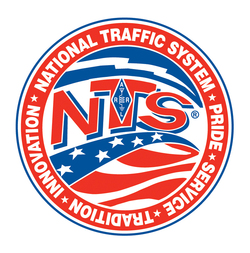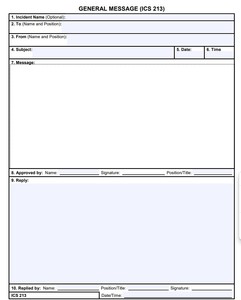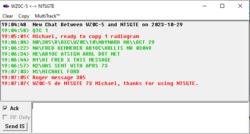 November 1, 2023 | |||
From the Editor We hope you enjoyed the premier issue of The NTS Letter. NTS 2.0 Update
ICS-213 Compatibility: Using Radiograms to Pass Served Agency Forms From the NTS2.arrl.org website:
As part of NTS 2.0, numerous NTS stations and EmComm operators have worked together to define methods and procedures for passing these various agency forms encapsulated within radiograms. This allows the NTS relay stations to handle radiograms as they are used to, while served agencies can continue to utilize their forms. The NTS 2.0 website discusses how to encode these complex forms for transmission through the National Traffic System as radiograms, and their final delivery to the served agency in the native form format. We realize that radiograms with encapsulated agency forms are much longer than traditional radiograms and take more time and effort when passed on CW or voice modes. We expect these forms to be passed primarily via digital modes for most emergencies, but there can indeed be circumstances when they need to be sent via voice or CW. This could be due to the scale and type of emergency, or because of delivering station capabilities. To be prepared for these circumstances, we hope voice and CW participants and their nets will take pains to become familiar with the forms and develop proficiency through the practice of handling the encoded forms on those modes. The NTS 2.0 Digital and EmComm working groups have developed encoding for:
It is anticipated that encoding for more forms will be established as we move forward. We will be updating this material as it is developed. Massachusetts Rhode Island Digital Net A New England NTS net played an integral role in a recent ARES Simulated Emergency Test on Cape Cod. The Massachusetts Rhode Island Digital Net (MARIDN) meets weekly for the purpose of passing formal, written NTS messages within, into, and out of the Sections of Eastern and Western Massachusetts and Rhode Island. MARIDN is supplemental to the Massachusetts Rhode Island Phone Net (MARIPN) and Massachusetts Rhode Island CW Net (MARICW). MARIDN uses digital modes rather than phone or CW, particularly the fldigi suite of software. One of the Many Tools in Our Toolbox The Cape & Islands ARES team has long embraced NTS as one of many tools in our toolbox for passing messages in emergencies. During exercises, the team routinely uses NTS procedures to pass formal traffic between field stations. For the recent exercise "Cyclone," held August 5, 2023, the Cape & Islands ARES team ran a tactical voice FM simplex net. Then participants passed formal, written NTS traffic via voice from field sites to exercise Net Control, then to exercise NCS liaison N1ILZ. Later in the exercise, N1ILZ was NCS for a session of MARIDN, during which NTS exercise traffic was passed to the greater NTS system for delivery. Conclusions: Tactical voice nets are essential for ARES emergency operations. But there will always be a need for a way to pass formal, written traffic. This is where NTS shines. NTS nets can employ voice, CW, and digital modes. MARIDN is exploring how to use the fldigi suite / NBEMS to operate an NTS net on HF (80 meters). Advantages include faster message transmission and error correction. The Cape & Islands ARES group fully embraces NTS as one of many "tools in the toolbox," including the relatively new MARIDN. Liven Up Your Routine Traffic As active traffic handlers, many of us have relayed or delivered a "Welcome to amateur radio" radiogram to a newly licensed amateur. Some folks do not like accepting these types of messages, claiming that it is next to impossible to deliver radiograms when they contain incorrect phone numbers or no phone numbers at all. Perhaps it is time to inject some variety into our routine traffic! Some folks have started creating fun "quiz" sessions where answers are submitted via radiogram. Others confirm their POTA (Parks On The Air) contacts via radiogram. One innovative amateur even offers free certificates for special event contacts, providing the other party "QSLs" via radiogram. (Otherwise, a self- addressed, stamped envelope is required.) The possibilities are endless; the only limit is your imagination. I would like to suggest another idea for originating meaningful routine traffic: Many ARES groups and clubs conduct communications for walkathons, parades, and other public service activities. Why not thank the participants via radiogram? The ham coordinator of the public service event keeps an accurate roster of the volunteers, complete with phone numbers and email addresses. They will no doubt welcome the efforts of a local traffic handler sending a radiogram message on their behalf expressing a "job well done." It's a perfect match! The public service radiogram can be a nice acknowledgement and, at the same time, inject some variety into our daily traffic routine. - New England Division Vice Director Phil Temples K9HI ME Traffic Handler Generates Radiograms from Local Library From the e-mailbag: Al Sirois, N1MHC, of East Boothbay, Maine reports that he, with K1CYJ and KC1TKR, collected 28 NTS messages at the local library during an event called "Booktoberfest" and transmitted these over the Maine NTS System that day. Al says Heather, KC1TKR, a new licensee, came approximately 50 miles from Oakland, ME to take part in this activity. According to the website at https://bbhlibrary.org/booktoberfest/, Booktober festivities included "Boothbay Region Amateur Radio Station - Join members of the N1MHC Ham radio team to learn about the fascinating world of amateur radio and send a message to a friend anywhere in the world!" Another good idea for traffic originations. GTE: An APRS-NTS Gateway APRS, an Automatic Packet Reporting System, is used by many amateur radio operators as a digital communications information channel, conveying announcements, bulletins, messages, alerts, and weather information. NTS Update from Atlantic Provinces of Canada The Canadian provinces have long been a part of NTS. In the Eastern Area Ontario, Quebec and the Atlantic Provinces were all part of what was called the 11th region, or ECN (Eastern Canada Net). ECN met nightly and sent a liaison station to the Eastern Area Net. Eventually, however, lack of participation caused that net to deactivate, and Eastern Canadian traffic was then routed via the 2nd region. Recently however, Glenn Killam, VE1IJ, who recently relocated from Ontario to Nova Scotia, has been collaborating with Joe Earles, VO1BQ, of Newfoundland to revive an Atlantic Provinces Net. Glenn's article, "Atlantic Area Amateurs Needed for Traffic Net," is being posted to TCA Magazine in Canada with hopes of recruiting new traffic handlers. Someday, ECN could operate again, but meanwhile Glenn uses the NTS to send radiograms welcoming new amateurs and congratulating hams on their upgrades throughout the US. Spotlight: Aaron Hulett, K8AMH Many of you are familiar with the NTS Trivia radiograms from Little Elm, Texas, or have been a part of the ARRLNTS group on groups.io.
The traffic handler behind both activities is Aaron Hulett, K8AMH. As you might tell from his call sign, Aaron grew up in Michigan where he was fascinated with weather, wondering how he could help during major storm systems. This led him to become involved with SKYWARN, which led him to amateur Radio. He received his license in 2005 and has been a big contributor ever since. His professional background has included program manager, paralegal, and software engineer. He currently works as a project manager for a managed service provider. As a ham radio operator, Aaron has been active in both NTS and emergency communications. He currently serves as Section Traffic Manager for the North Texas Section and is a regular net control on the DFW (Dallas-Fort Worth) Metroplex Traffic Net, which is an affiliate of the ARRL National Traffic System. He has also been assisting with the NTS 2.0 initiative to help expand participation and lay the groundwork for how the NTS can assist in today's incident response environment. He became involved in traffic handling after hearing the DFW traffic net shortly after moving to the area in 2017, and quickly became interested after seeing the potential the traffic system offered. As a STM, he feels one of his primary responsibilities is to push the system to move out of its comfort zone and embrace growth and change. He has conducted a traffic system exercise simulating an infrastructure failure in the Dallas-Fort Worth area and coordinated with the Oklahoma and South Texas Sections to execute an exercise simulating widespread hurricane destruction affecting Houston. These have provided valuable insight into how the system can respond, and what areas to look at for refining operations and developing new best practices for traffic handlers, net control stations, and Section Traffic Managers overseeing operations. Outside of amateur radio, you might find Aaron at a local amusement park, where he enjoys riding roller coasters, especially those with airtime. If you find yourself at Cedar Point, you may catch him riding Magnum XL-200 repeatedly during opening and closing weekends. NTS Resources The National Traffic System® (NTS) is a network of amateur radio operators who move information during disasters and other emergencies. General messages offering well wishes also move through the NTS to help test the system and to help amateur radio operators build traffic handling skills. While the NTS is primarily set up to serve the United States and Canada, it is possible to move traffic internationally through the NTS through various local, regional, area, and international network connections.
Sign up to receive The NTS Letter The NTS Letter is published monthly and is free of charge to ARRL members. Subscribe: arrl.org/opt-in-out Editor: Marcia Forde, KW1U, Section Traffic Manager -- Eastern Massachusetts, Western Massachusetts, and Rhode Island ARRL Director of Emergency Management: Josh Johnston, KE5MHV ARRL Emergency Management Planner: Jeremy Dunkley, KC1SIV Support NTS: Join ARRL NTS is a program of ARRL The National Association for Amateur Radio®. No other organization works harder than ARRL to promote and protect amateur radio! ARRL members enjoy many benefits and services including digital magazines, e-newsletters, online learning (learn.arrl.org), and technical support. Membership also supports programs for radio clubs, on-air contests, Logbook of The World®, ARRL Field Day, and the all-volunteer ARRL Field Organization.
| |||
 We heard from many of you and thank you for your kind words of support. We hope you will spread the word to others. Feel free to share this newsletter with those who may or may not be ARRL members but who have shown an interest in message handling. (Of course, you could encourage non-members to join.) Also remember to send news or suggestions from your Sections. We want to hear from you.
We heard from many of you and thank you for your kind words of support. We hope you will spread the word to others. Feel free to share this newsletter with those who may or may not be ARRL members but who have shown an interest in message handling. (Of course, you could encourage non-members to join.) Also remember to send news or suggestions from your Sections. We want to hear from you.








